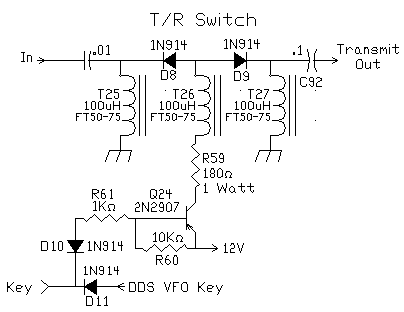


| Section 1 of Board 1 is shown above. The DDS VFO is on the left, the VFO amplifiers in the middle with one IR Receiver (black, bent over) controlled MOSFET amplifier and one 2N5109 amplifier, and the T/R switch on the right. The 5V regulator (tab heatsink) with capacitors for the DDS is on the bottom right. |


| This simplified T/R circuit comes from "W1FB's QRP NOTEBOOK", by Doug DeMaw, W1FB, 1991. It was designed for 5 watt transmitters and is adapted for the Blue Lightning Transceiver. |

|
This is a full QSK diode T/R transmit/receive circuit. Ordinary switching diodes are used. Other pin diodes and schottky diodes were tried but the 1N914's had the lowest loss and worked the best. The small diodes provide the best input-output isolation because of the smaller junctions and less junction capacitance. (Doug DeMaw, W1FB's QRP Notebook, page 141) There is approximately 38 dB of input-output isolation. The diodes must be fully turned on or they will be lossy. Approximately 30 mA of DC is used for each switching diode. The chokes have an XL of 600 ohms minimum to provide an overall XL of 200 ohms, which is the lowest acceptable value for a 50 ohm line. (Doug DeMaw, W1FB's QRP Notebook, page 141) In this circuit, the chokes are hand wound on FT50-75 ferrite cores (100uH) for the lowest DC resistance for quick turn-on of the diodes. According to W1FB, the switch has 0.7 dB loss, which is minimal at the 200 mW level at the output of the VFO amplifier chain. The circuit keys Q24 on and off between transmit and receive modes. In Transmit, Q24 is turned off by the positive forward bias applied to its base. In Receive, R4 turns on Q24 to pass DC current to D8 and D9. (Doug DeMaw, W1FB's QRP Notebook, page 142) The original circuit was modified so that it would work for the T/R switching in the Blue Lightning Transceiver. |

Send E-Mail || Amateur Radio Receivers || Blue Lightning Transceiver

Last Update: 4/3/2021
Web Author: David White, WN5Y
